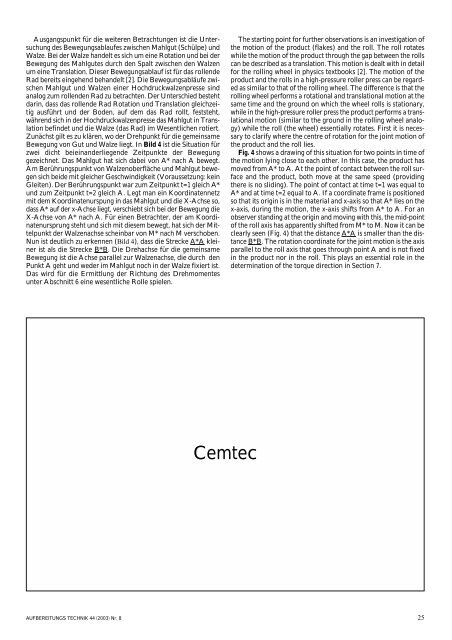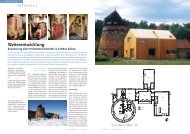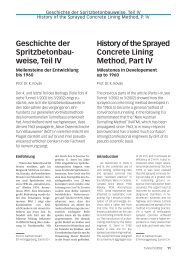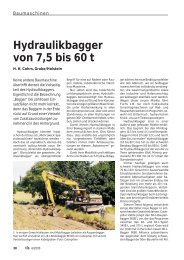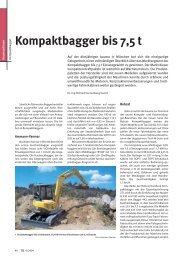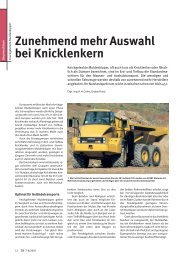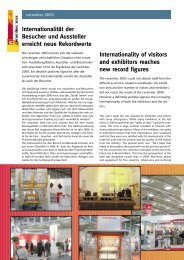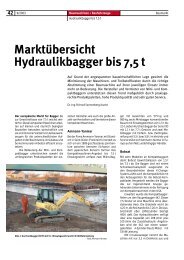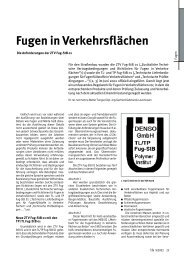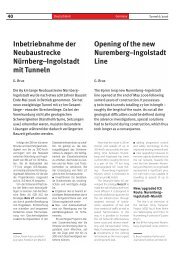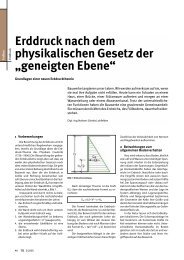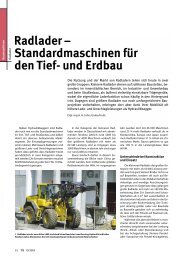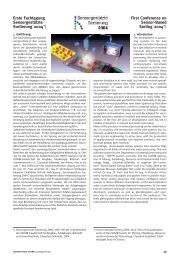Kraftverteilung im Arbeitsspalt von Hochdruck ... - Bauverlag
Kraftverteilung im Arbeitsspalt von Hochdruck ... - Bauverlag
Kraftverteilung im Arbeitsspalt von Hochdruck ... - Bauverlag
Erfolgreiche ePaper selbst erstellen
Machen Sie aus Ihren PDF Publikationen ein blätterbares Flipbook mit unserer einzigartigen Google optimierten e-Paper Software.
Ausgangspunkt für die weiteren Betrachtungen ist die Untersuchung<br />
des Bewegungsablaufes zwischen Mahlgut (Schülpe) und<br />
Walze. Bei der Walze handelt es sich um eine Rotation und bei der<br />
Bewegung des Mahlgutes durch den Spalt zwischen den Walzen<br />
um eine Translation. Dieser Bewegungsablauf ist für das rollende<br />
Rad bereits eingehend behandelt [2]. Die Bewegungsabläufe zwischen<br />
Mahlgut und Walzen einer <strong>Hochdruck</strong>walzenpresse sind<br />
analog zum rollenden Rad zu betrachten. Der Unterschied besteht<br />
darin, dass das rollende Rad Rotation und Translation gleichzeitig<br />
ausführt und der Boden, auf dem das Rad rollt, feststeht,<br />
während sich in der <strong>Hochdruck</strong>walzenpresse das Mahlgut in Translation<br />
befindet und die Walze (das Rad) <strong>im</strong> Wesentlichen rotiert.<br />
Zunächst gilt es zu klären, wo der Drehpunkt für die gemeinsame<br />
Bewegung <strong>von</strong> Gut und Walze liegt. In Bild 4 ist die Situation für<br />
zwei dicht beieinanderliegende Zeitpunkte der Bewegung<br />
gezeichnet. Das Mahlgut hat sich dabei <strong>von</strong> A* nach A bewegt.<br />
Am Berührungspunkt <strong>von</strong> Walzenoberfläche und Mahlgut bewegen<br />
sich beide mit gleicher Geschwindigkeit (Voraussetzung: kein<br />
Gleiten). Der Berührungspunkt war zum Zeitpunkt t=1 gleich A*<br />
und zum Zeitpunkt t=2 gleich A. Legt man ein Koordinatennetz<br />
mit dem Koordinatenurspung in das Mahlgut und die X-Achse so,<br />
dass A* auf der x-Achse liegt, verschiebt sich bei der Bewegung die<br />
X-Achse <strong>von</strong> A* nach A. Für einen Betrachter, der am Koordinatenursprung<br />
steht und sich mit diesem bewegt, hat sich der Mittelpunkt<br />
der Walzenachse scheinbar <strong>von</strong> M* nach M verschoben.<br />
Nun ist deutlich zu erkennen (Bild 4), dass die Strecke A*A kleiner<br />
ist als die Strecke B*B. Die Drehachse für die gemeinsame<br />
Bewegung ist die Achse parallel zur Walzenachse, die durch den<br />
Punkt A geht und weder <strong>im</strong> Mahlgut noch in der Walze fixiert ist.<br />
Das wird für die Ermittlung der Richtung des Drehmomentes<br />
unter Abschnitt 6 eine wesentliche Rolle spielen.<br />
The starting point for further observations is an investigation of<br />
the motion of the product (flakes) and the roll. The roll rotates<br />
while the motion of the product through the gap between the rolls<br />
can be described as a translation. This motion is dealt with in detail<br />
for the rolling wheel in physics textbooks [2]. The motion of the<br />
product and the rolls in a high-pressure roller press can be regarded<br />
as s<strong>im</strong>ilar to that of the rolling wheel. The difference is that the<br />
rolling wheel performs a rotational and translational motion at the<br />
same t<strong>im</strong>e and the ground on which the wheel rolls is stationary,<br />
while in the high-pressure roller press the product performs a translational<br />
motion (s<strong>im</strong>ilar to the ground in the rolling wheel analogy)<br />
while the roll (the wheel) essentially rotates. First it is necessary<br />
to clarify where the centre of rotation for the joint motion of<br />
the product and the roll lies.<br />
Fig. 4 shows a drawing of this situation for two points in t<strong>im</strong>e of<br />
the motion lying close to each other. In this case, the product has<br />
moved from A* to A. At the point of contact between the roll surface<br />
and the product, both move at the same speed (providing<br />
there is no sliding). The point of contact at t<strong>im</strong>e t=1 was equal to<br />
A* and at t<strong>im</strong>e t=2 equal to A. If a coordinate frame is positioned<br />
so that its origin is in the material and x-axis so that A* lies on the<br />
x-axis, during the motion, the x-axis shifts from A* to A. For an<br />
observer standing at the origin and moving with this, the mid-point<br />
of the roll axis has apparently shifted from M* to M. Now it can be<br />
clearly seen (Fig. 4) that the distance A*A is smaller than the distance<br />
B*B. The rotation coordinate for the joint motion is the axis<br />
parallel to the roll axis that goes through point A and is not fixed<br />
in the product nor in the roll. This plays an essential role in the<br />
determination of the torque direction in Section 7.<br />
Cemtec<br />
AUFBEREITUNGS TECHNIK 44 (2003) Nr. 8 25


